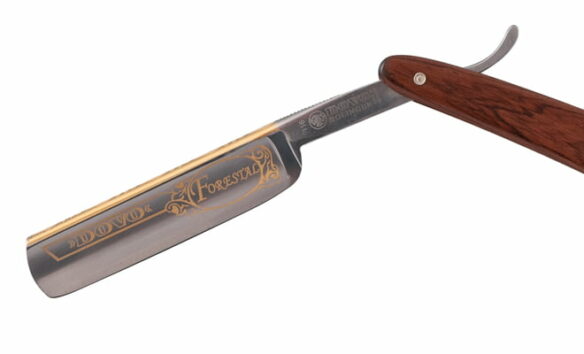If you want to get the most from your straight razor, one thing that you must know is straight razor maintenance. These razors are quite unlike your ordinary cartridge razor which requires replacing after the blade becomes too old (roughly after 10 shaves). With proper care and maintenance, a straight razor can last you as long as you live. In this article, we walk you through the things that you need to know insofar as straight maintenance and care go. We begin by telling you what they are made of because with this knowledge, you will be able to better care for them.
Materials
Generally speaking, most straight razor blades are made from steel with the more recent ones having blades manufactured from stainless steel. Etched or engraved on the razor blades are the markings that identify the manufacturer or razor model. Straight razor handles are usually made from different materials and these include celluloid, rubber, horn, wood, ivory, vegetable ivory, bakelite, and metal. Additions and inlays can be made from copper, silver, ivory, wood, mother of pearl, and tortoiseshell among many other materials.
Caring for your straight razor
Having known the materials of which a straight razor has been made, we will now tell you the correct maintenance practices for the razor based on these materials.
Where to store the straight razor?
- The best way to store your razor is in a well-ventilated and dark room with a temperature of 20 °C or 72 °F.
- The place should neither be too damp or too dry.
- A good place to store them is near the front part of the drawer. This allows free circulation of air and this is even more important if your razor is made of celluloid material.
- Avoid areas that can get very hot, for instance the attic. This is because celluloid tends to be very flammable.
- They should be kept as far away from water as possible as water will make razors that are iron-based to rust. Also, water can damage many handle materials.
Proper maintenance of the straight razor blade
- Metal polishes like Silvo, Autusol or Brasso should never ever be used on your straight razor blade. Other than damaging the surface, these also leave behind polish residues that are not only unattractive but also harmful to handle and blade.
- In case the blade is very nicked or dull, it is recommended to use a sharpening stone. You can also use leather razor strop in maintaining a keen edge. If you are able to cut a piece of paper using your razor, then you are mighty close.
- It is not unusual to come across rust on straight razor blades and more so the earlier razor blades made before stainless steel was invented. You may get rid of this rust by means of either a 0000 steel wool or a soft 3Mscrub pad. Take care not to scratch its handle!
- After that, clean the blade’s entire surface using a Q-tip made wet by rubbing or ethyl alcohol. The importance of this is to decrease the blade. Next, have a thin layer of light mineral applied to your blade and leave it for 10 minutes or so. Wipe excess oil by using a dry and clean cloth. The oil coating helps to prevent further rusting.
- After using your straight razor, make sure you have removed excess oil by means of rubbing alcohol. Mineral oil can re-oil the blade so apply it after use and also after sharpening.
Handle maintenance tips
- Avoid coatings like waxes, lacquers, polishes and oils since these tend to trap dirt and chemicals which accelerate deterioration rates.
In the same way, avoid cleaning the handle of the blade with soaps or detergents as these also cause damage. - Never soak or immerse handle in water. Instead, wipe it using a damp cloth. Dry it immediately after cleaning by using an absorbent cloth. In order to cut grease that is present on the handle, use a combination of household ammonia and distilled water and rinse quickly with a damp cloth and then dry.
- For wooden handles, erase the dirt carefully by means of a soft and whit vinyl eraser. Wipe away eraser bits by means of soft bristle brush.
- In case your razor is broken, do not attempt to repair it yourself. Some adhesives may cause the materials to be damaged. Also, some repairs could cause an even greater loss of value than the damage itself. The best thing is to talk to a conservator who knows about materials involved.
- Track your razor blades and watch if there are any deterioration signs. Change of color, cracking, flaking, odors, bubbling and warping among other things are signs of deterioration.
- Identify and store separately all the deteriorating razors from your collection as this prevents further damage.
Conclusion
Dos
- Thoroughly rinse your razor after every use, ensuring that you get rid of all the trace soap.
- Let it dry before you store it inside its box.
- Keep it out of children’s reach! Kids appear to love these very much and it can be very dangerous to them.
- Give it the respect.
- Always treat it with the respect you’d show anything that’s very sharp.
Don’ts
- Bang the blade’s on the sink when rinsing as it can break
- Use it to lance or behead a boil, you won’t like the results
- Use it for any other purpose than the one it was intended for
- Leave the straight razor in the open as you lather your face
Generally, if you stick to the basic care above, you can expect your razor to remain in top shape for a long, long time. But if it has serious concerns like adhesive residues, cloudy tortoiseshell handle or broken handle, it is ideal to consult an expert. Attempting to repair it yourself could cause more damage or even loss in its value. Always see a pro to maintain your straight razor as this will ensure that you get the best from your razor.

